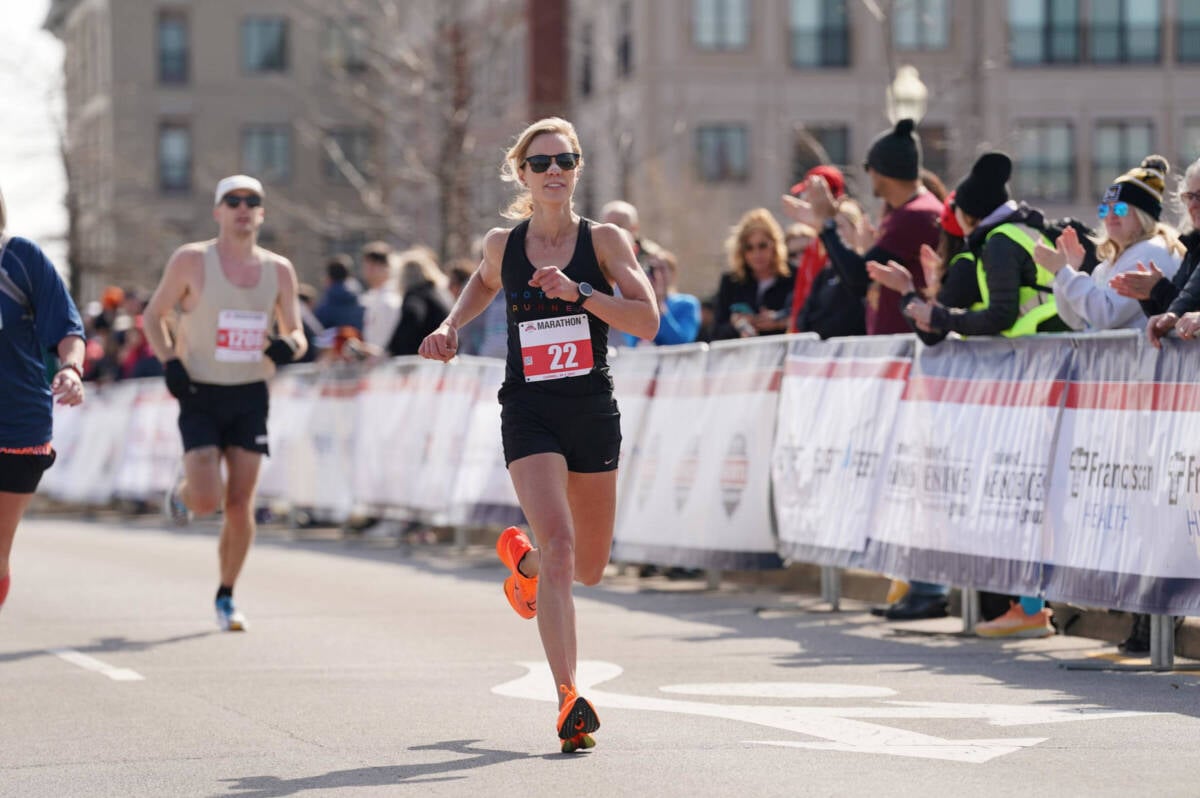Pro Racing Tactics to Nail Your Next Running Race
Racing tactics can help runners perform their best. They tell you when it’s best to push to gain an edge or pull back to conserve energy, and be prepared for anything. Several-time Olympic Trials Qualifier Neely Gracey shares some of her pro racing tips such as running tangents, surging past competitors, and practicing water stops. Read on to learn more.

In 2022, I had been on a three-year hiatus from running races thanks to COVID and running injuries. As I ripped off the bandaid and raced my first races this fall, I realized I need to sharpen my racing strategies for my goal marathon. Don’t get me wrong. I had successful races. I set a half marathon PR of 1:20 in the first and won a half marathon in the second. But I had huge areas of improvement.
Table of contents
My Racing Tactics Mistakes
In my first half marathon, I was proud of how I ran the tangents and used runners around me to pick up speed.
However, I got lost! I was waved the wrong way in my first half marathon, running a quarter mile out of the way. I was by myself and on track for a sizable PR. When I realized I wasn’t on the racecourse anymore, I sprinted back and then tormented myself over the mistake. “There goes my PR! Should I even try?” I thought.
I was able to stop the negative spiral and unofficially set a 2-minute PR for a time 1:20 and officially tie my half-marathon PR with a time of 1:22.
In my second half-marathon tune-up, I ran by myself the entire time and had a difficult time switching gears and finding the edge. I found myself making excuses for why I wouldn’t come close to the paces my race plan had dictated.
I also really struggled with the water stops. There weren’t people handing out the water cups, so I had to come to a complete stop to grab them. The water sloshed around, and I hardly got any fluids. Not getting enough hydration isn’t a death sentence for a cool half marathon but for a marathon it could spell game over.
Racing also highlighted that I need to really needed to work on my mental game. Negative thoughts can quickly creep in and spiral out of control. I, and all runners, need to learn racing strategies that shut these negative thoughts down and replace them with only calm, confidence, and positivity.

The Importance of Racing Tactics
Racing strategies are key for racing success. Don’t expect to wing it and succeed.
I want to nail my goal marathon this fall. I do not want to disappoint myself by not doing my best because I made logistical mistakes or let my head get the best of me. I’ve trained my body hard to run 26.2 miles faster than I ever have. And my mind either needs to help it out or get out of the way!
To get myself (and YOU!!) race ready, I got with mother runner former pro runner for Adidas, and several-time Olympic Trials Qualifier, Neely Gracey.
Gracey offers both tactical and mindset racing strategies so you can perform your best on race day.
So, buckle up and let’s go!
8 Racing Strategies to Race Your Best
1. Run the tangents.
It seems like common sense—you don’t want to run farther in a race than you are supposed to. Yet so many runners end up running much farther than 13.1 or 26.2 miles because they don’t run the tangents.
Running the tangents means running the shortest distance between two straight lines. You do this by knowing the course as best you can and looking ahead to see where the next turn is.
In major races, there will be a blue line you can follow to run the exact race distance.
When doing turns, be careful not to take the turn too tight or too far out. According to Gracey, you want to give yourself a little room so you don’t have to slow down too much but not too much room that you are running way out of the way. Ideally, you are taking turns on the outside of one or two runners.
If you have to cross a street to make a turn, cross at a diagonal, not straight across.
When you cross the finish line and your watch reads longer than 26.2 or 13.1 miles, don’t freak out, Gracey says. GPS watches can be inaccurate, especially on courses with lots of turns. GPS watches work by dropping pins and connecting them. When there are lots of turns, the distance will be off. Keep this in mind if your watch beeps before the mile marks.
2. Surge!
Surges are when you speed up your pace by a gear or two. Surges aren’t sprints—they are just a moderate increase in pace. And they are one of the most powerful racing strategies.
I used surges in my first half marathon this fall and was able to cut keep my pace about 10 seconds faster per mile just by putting in a bit of extra effort for 30 seconds or so.
Here’s how they work: when someone is coming up behind you, pick up the pace to lose them. If you see something in your line of sight, like a streetlight, water stop, or another runner, surge to them and then settle back into your pace. Or, if you feel like you are starting to fade or fall off pace, surge!
Gracey says surges help trigger your body to switch gears—lengthening your stride and picking up your knee drive. Don’t be surprised if, after a surge, your set pace quickens.
You can practice surges on your long runs. For every other long run, Gracey will do one-minute surges in the second half of the run where she picks up the pace to a 10k or half marathon pace. This teaches her body to run fast on fatigued legs and clear byproducts in the process. It also sets you up for a negative split!
3. Practice water stops!
Water stops are the bane of my existence! They can be crowded. It’s so hard to grab a cup and not break stride. And it’s nearly impossible to not have it spill out everywhere, so you barely get any hydration.
What can you do?
- First, practice running past someone and grabbing cups.
- Second, Gracey advises, grabbing two cups and fold the top to stop spilling.
- Practice drinking on the run.
- Finally, (and this is probably what I will try to do), run with a water bottle.
I hate running and holding things, but the chaos of a water stop is a powerful motivator. Gracey suggests having a water bottle for the first half of the race—the most important when it comes to hydration and nutrition—and then doing water stops for the second half if you hate holding something.
It’s a wise idea to sign-up for a couple of races in your training cycle to practice water stops or running with a water bottle at a fast pace.
4. Redirect your thoughts.
Your mind can only think of one thing at once, shares Gracey, who works regularly with a sports psychologist.
So, when your brain gets stuck in a negative thought spiral, redirect it.
- You can start thinking of everything that is going well of feeling good.
- You can repeat a mantra that uses the third person like “you got this.” Research shows using “you” is better registered by your brain.
- Flip negative thoughts on its head. If your legs are getting tired, for example, think about how strong they are getting.
- Recall training moments and races where you performed well or pleasantly surprised yourself. Focus on how good you felt and channel that energy. (Write about these in a journal, training diary, or Instagram to reinforce the feeling throughout your training!)
- Develop an inner superhero or “alter ego” (like Beyonce has Sasha Fierce) that makes you feel confident and empowered.
Racing is going to hurt. Continue to push even when your brain says no. Tapping into these racing strategies will help get your body (and mind!) back on track. Then stay in the moment and remind yourself you can do hard things.
5. Race often.
When I race, I often find myself making excuses for why I didn’t perform to the best of my ability. How do you stop this? Gracey says it requires race maturity which comes with race experience.
So! Race often.
Racing during a training cycle was new to me—and I know it is novel to a lot of other runners. But only training for one big day can set you up for failure.
Every time we race, says Gracey, we teach our bodies that it can push harder and go farther. In the first race, you may start to feel bad at the halfway point. Second, you may feel good until the last couple of miles. For the third race, you may feel strong the whole way through.
Racing often helps calm nerves and trains the body and mind to push the barrier a bit further.
“We want to practice these things that are making us physically and mentally fit, so when put together and we have the whole package,” explains Gracey.
6. Practice worst-case scenarios.
A perfect race day—especially a perfect marathon—is an elusive, mystical unicorn. As runners, we want to control everything, but we cannot. Our shoe may come untied. It may pour. We may have to use the port-a-potty.
When you’re visualizing running the race and feeling strong, also visualize how you will handle something going wrong. Imagine yourself dealing with the matter at hand calmly and confidently. Moving on and staying in the moment.
Gracey calls this “compartmentalizing” and it’s an incredible racing strategy and skill to have in life.
Your toddler melts down and creates a scene at the store. Pick them up, remove them from the situation, and move on. Don’t let it wreck your day.
As moms we are adept at moving from role to role—work this skill into your racing. Put out the fire and keep going.
As Gracey puts it: “I’ve learned I can only control myself—my mind, my approach—so in every race, I focus on just me and performing the best I could on that day.”
7. Focus on your breath, not your watch.
Our GPS watches can be a friend or foe when it comes to racing. They can help us stay on track, but they can also induce anxiety and trigger negative feelings.
Most elite runners do not focus on their watches. Most elite runners pay attention to how they feel, what their rate of perceived exertion is. Emily Sisson who set the American record for the marathon in the Chicago Marathon this year only looked at her watch once!
To take the focus off your watch:
- Try counting your breaths and steps. Gracey knows if she is running at the right effort if she takes an inhale for two steps and exhales for two steps (2:2 breathing pattern).
- Set your watch to cadence or heart rate—something that isn’t as triggering as pace.
- Distract yourself. Focus on surroundings such as the people around you, the view, or listening to podcasts or music.
8. Give yourself grace.
Practicing self-compassion is a beautiful skill that serves us well in almost everything we do. It is also one of the most effective racing strategies.
I love how Gracey says she focuses on doing her best THAT DAY. This recognizes that not every race is created equal. In some races, we will feel great and in others, we may just not have it.
So, don’t fall into the comparison trap. Instead, focus on doing the best you can in a given situation. If you can do that, then you should cross the finish line feeling proud.
This racing strategy really struck a chord in me. In my second half marathon—while it was a moment of a lifetime to break the tape with my kids there to see—I was down on myself for not running anywhere near my projected race pace.
But upon reflection, I did my best. I pushed hard. And my legs were very sore for the week after—cementing that I got out of my body what I could that day.
Keeping it simple—do what you can at the moment—can help quiet the chatter and make yourself proud.
After all, that’s what we truly are after, right?
FAQs about Race Tactics
What are some running strategies?
The very running strategies are to practice, practice, practice. Practice what you will wear, eat, and drink on race day and do the night and morning of the race. Leave nothing to chance. Control as many controllables as you can.
And, if possible, race during your training cycle for your goal race. This will help you iron out your race day routine and fix any kinks in the process. Racing often will also help you mentally cope with the discomfort that comes with running hard and any race-day anxiety.
How do you win a race against someone faster?
The best way to race against someone faster than you is to use them to your advantage.
Here’s how to beat someone faster than you:
- Start out the race in a controlled fashion. DO NOT go out too fast and blow up.
- Begin your set zone and after a couple of miles (depending on the race distance) pick up the pace.
- If you feel like your competitor is hurting, surge in front of them.
- Blow hard past them on hills.
- Be sure to position yourself on the outside of turns so you don’t get boxed in.
- Draft (run behind them) and let them block wind resistance for you so you use less energy when you run.
- Kick it in when you get near the end of the race. Dig deep and leave them in your dust!
How do you gain confidence in racing?
The key to coping with race anxiety and getting more confidence in racing is practicing racing and racing strategies as much as you can!
- Plan several races in your training cycle to finetune your routine and racing strategies.
- Review your training and reflect on the work you’ve put in, particularly on the workouts you performed well.
- Visualize the morning of the race, the race itself, and how you feel after. Think through how you will overcome obstacles and imagine what you feel like when you give your and when you don’t.
- Imagining the disappointment if you don’t give your training the race it warranted can be a powerful motivator once you enter the pain cave.
If you want guidance with your running, including racing strategies, check out my run coaching services. Do you practice any race tactics when running?






